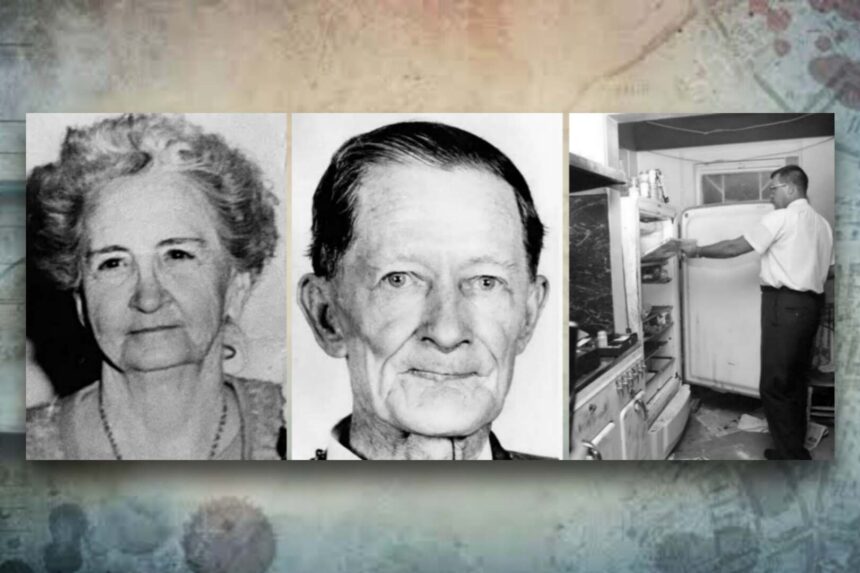In 1965, one of the most horrifying and perplexing crimes in Houston, Texas, took place; the case remains unsolved. Fred and Edwina Rogers’ disfigured bodies were discovered in their own home, meticulously kept in their refrigerator. Investigators were left with more questions than answers due to the horrific nature of the crime and the sudden disappearance of their son, Charles Rogers. Known as the “Icebox Murders,” the case continues to trouble law enforcement and those who enjoy crime.
Discovery of the Crime Scene
On June 23, 1965, Fred (81) and Edwina Rogers (79) were the subjects of a welfare check by Houston police officers who were summoned to 1815 Driscoll Street, a modest house in the Montrose neighborhood. A worried relative who hadn’t heard from them in days made the call. Officers knocked on the door when they arrived but got no answer.
After discovering that the doors were locked, the cops broke in and searched the building. There was a bad smell in the air, but the house looked oddly tidy. One officer opened the refrigerator and saw shelves piled high with carefully sliced slabs of human flesh, a scene from a horror movie.Further inspection revealed two human heads wrapped in plastic within the vegetable crisper.
The Autopsy and Investigation
A forensic analysis showed how heinous the killings were. Fred’s skull was broken from multiple blows, and he had been hammered to death. Edwina had been shot in the head, execution style. Investigators concluded that the perpetrator had considerable anatomical knowledge because the bodies were surgically mutilated with great care after they died.
Oddly, there were no indications of a struggle or forced entrance. Before chopping them up and putting the remnants in the refrigerator, the murderer had spent their time draining the bodies of blood in the bathtub. Internal organs, however, were nowhere to be found in the residence, indicating that they had been taken out and perhaps thrown away.
The Prime Suspect: Charles Rogers
Charles Rogers, the 43-year-old son of the couple, quickly became the prime suspect. A former seismologist and a reclusive figure, Charles lived with his parents in the same home but was rarely seen by neighbors. Those who knew him described him as highly intelligent but deeply secretive.
When police searched the house, they discovered Charles’ room was strangely untouched, except for the absence of his personal belongings. A bloodstained keyhole and blood spatter suggested he may have locked himself in after committing the murders. Most importantly, Charles Rogers was missing.
Investigators speculated that Charles had endured years of emotional and possibly physical abuse from his parents. According to reports, Edwina was overbearing, while Fred was physically violent. Some accounts suggest Charles had been manipulated and financially controlled by his parents. This potential motive, combined with the clean execution of the murders and Charles’ sudden disappearance, convinced authorities that he was the killer.
Theories and Speculation
Despite police naming Charles Rogers as the primary suspect, they were never able to locate him. Many theories arose regarding his whereabouts and the motive behind the murders:
The Escape and New Identity Theory: Some believe Charles meticulously planned the murders and fled the country. Given his intelligence and past employment with the U.S. Navy and Shell Oil as a geophysicist, it is possible he had the knowledge and resources to assume a new identity and disappear without a trace.
The CIA Connection Theory: One of the most bizarre but widely circulated theories is that Charles Rogers was involved in espionage and possibly even connected to the JFK assassination. Some theorists believe he was a CIA operative who had to eliminate his parents because they had discovered sensitive information about his activities. The precision of the dismemberment and his ability to vanish lend some credibility to this theory.
The Suicide Theory: A less popular theory suggests that after committing the murders, Charles may have taken his own life in a remote location, never to be found. However, no evidence supports this theory, as no remains have ever been recovered.
The Underground Network Theory: Another theory suggests Charles may have sought refuge with criminal organizations or people who specialized in hiding fugitives. His intelligence and ability to speak multiple languages could have aided his escape.
The Aftermath and Unsolved Mystery
Despite an extensive manhunt, Charles Rogers was never found. He was declared legally dead in 1975, ten years after the gruesome murders. The house on Driscoll Street was eventually demolished, but the dark legacy of the Icebox Murders remains.
Over the decades, the case has been the subject of numerous books, documentaries, and crime podcasts, but no new leads have surfaced. The crime scene’s level of precision, lack of concrete evidence, and Charles Rogers’ sudden disappearance make it one of the most baffling cold cases in American history.
Conclusion
The Icebox Murders of Fred and Edwina Rogers remain a chilling and unsolved case. The lack of physical evidence, combined with Charles Rogers’ disappearance, has left investigators and crime enthusiasts alike speculating for decades. Whether Charles was a cold-blooded murderer, a victim of long-term abuse who snapped, or an operative caught up in something far bigger, his whereabouts and ultimate fate remain unknown.
To this day, the Icebox Murders stand as one of Houston’s most terrifying unsolved crimes, a haunting reminder of how the most horrifying acts can happen behind closed doors—even in the most unassuming neighborhoods.




